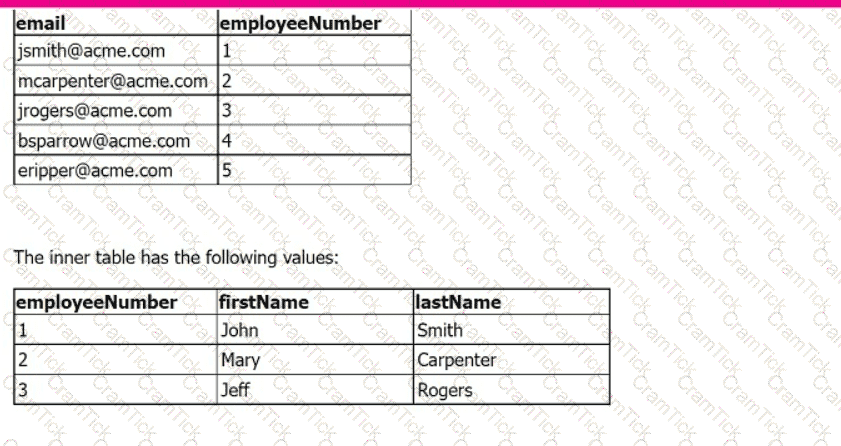For the following search, which field populates the x-axis?
index=security sourcetype=linux secure | timechart count by action
A user wants to create a workflow action that will retrieve a specific field value from an event and run a search in a new browser window
in the user's Splunk instance. What kind of workflow action should they create?
When using the transaction command, what is the assigned timestamp for each of the resulting transactions?
Which of the following statements would help a user choose between the transaction and stats commands?
This function of the stats command allows you to return the middle-most value of field X.
Which of the following workflow actions can be executed from search results? (select all that apply)
For the following search, which command would further filter for only IP addresses present more than five times?
Which of the following statements describe the search string below?
| datamodel Application_State All_Application_State search
Data model are composed of one or more of which of the following datasets? (select all that apply.)
Which of the following commands connects an additional table of data directly to the right side of the existing table?
Given the following eval statement:
... | eval field1 = if(isnotnull(field1),field1,0), field2 = if(isnull(field2), "NO-VALUE", field2)
Which of the following is the equivalent using fillnull?
Which of the following is included with the Common Information Model (CIM) add-on?
By default, how is acceleration configured in the Splunk Common Information Model (CIM) add-on?
What are the expected search results from executing the following SPL command?
index=network NOT StatusCode=200
Which of the following definitions describes a macro named "samplemacro" that accepts two arguments?
When creating a search workflow action, what character(s) are used as a placeholder for field values in the search string?
which of the following commands are used when creating visualizations(select all that apply.)
To identify all of the contributing events within a transaction that contains at least one REJECT event, which syntax is correct?
Given the following eval statement:
...| eval fieldl - if(isnotnull(fieldl),fieldl,0), field2 = if(isnull
Which of the following is the equivalent using f ilinull?
Which knowledge object is used to normalize field names to comply with the Splunk Common Information Model (CIM)?
Two separate results tables are being combined using the join command. The outer table has the following values:
The inner table has the following values:

The line of SPL used to join the tables is: join employeeNumber type=outer
How many rows are returned in the new table?
The macro weekly_sales (2) contains the search string:
index=games | eval ProductSales = $Price$ * $AmountSold$
Which of the following will return results?
There are several ways to access the field extractor. Which option automatically identifies data type, source type, and sample event?
Where are the descriptions of the data models that come with the Splunk Common Information Model (CIM) Add-on documented?
What is the correct Boolean order of evaluation for the where command from first to last?
A POST workflow action will pass which types of arguments to an external website?
Which of the following expressions could be used to create a calculated field called gigabytes?
Which of the following statements best describes the search string below?
| datamodel Application_State search
Which of these is NOT a field that is automatically created with the transaction command?
A user wants to create a new field alias for a field that appears in two sourcetypes.
How many field aliases need to be created?
If a calculated field has the same name as an extracted field, what happens to the extracted field?
What approach is recommended when using the Splunk Common Information Model (CIM) add-on to normalize data?
After manually editing; a regular expression (regex), which of the following statements is true?
In most large Splunk environments, what is the most efficient command that can be used to group events by fields/
A user wants to convert numeric field values to strings and also to sort on those values.
Which command should be used first, the eval or the sort?
Which field will be used to populate the field if the productName and product:d fields have values for a given event?
| eval productINFO=coalesco(productName,productid)
Two separate results tables are being combined using the |join command. The outer table has the following values:
Refer to following Tables

The line of SPL used to join the tables is: | join employeeNumber type=outer
How many rows are returned in the new table?
Which of the following statements describes the command below (select all that apply)
Sourcetype=access_combined | transaction JSESSIONID
Which of the following searches will show the number of categoryld used by each host?
Which of the following search control will not re-rerun the search? (Select all that apply.)
Which of these stats commands will show the total bytes for each unique combination of page and server?
When would a user select delimited field extractions using the Field Extractor (FX)?
Marty has multiple data sources that contain fields with IP Address values. What knowledge object should he use to normalize the fields so his data is CIM compliant?
Select this in the fields sidebar to automatically pipe you search results to the rare command
Data models are composed of one or more of which of the following datasets? (select all that apply)
Splunk Core Certified Power User | SPLK-1002 Questions Answers | SPLK-1002 Test Prep | Splunk Core Certified Power User Exam Questions PDF | SPLK-1002 Online Exam | SPLK-1002 Practice Test | SPLK-1002 PDF | SPLK-1002 Test Questions | SPLK-1002 Study Material | SPLK-1002 Exam Preparation | SPLK-1002 Valid Dumps | SPLK-1002 Real Questions | Splunk Core Certified Power User SPLK-1002 Exam Questions


